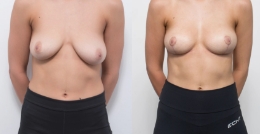Procedure gallery View our patient results








Disclaimer:
The outcomes shown are only relevant for this patient and do not necessarily reflect the results other patients may experience, as results may vary due to many factors, including the individual’s genetics, diet and exercise. Some images may have the patient’s tattoos, jewellery or other identifiable items blurred to protect patient identities.
What is Breast Reduction Mammoplasty?
Breast reduction, or reduction mammoplasty, is a surgical procedure that removes excess breast tissue, fat, and skin to reduce breast size. This procedure is suitable for patients experiencing physical discomfort such as back, neck, and shoulder pain, skin irritation, or difficulties with physical activity due to increased breast size. The focus of breast reduction mammoplasty is to address these functional concerns while making specific changes to breast size and shape in a way that supports physical comfort and mobility.
The procedure involves making incisions to remove excess tissue and reshape the remaining breast structure, with the goal of achieving a more proportionate breast size. In cases where a significant reduction is performed, the nipples and areolas may also be repositioned to align with the new breast shape. The choice of surgical technique depends on factors such as breast size, tissue composition, and the patient’s specific needs.
Our Philosophy on Breast Reduction Mammoplasty Surgery
At Dr Eddie Cheng’s clinic, breast reduction mammoplasty surgery is approached with a focus on patient-centred care and functional changes tailored to individual needs. Each patient is assessed based on their anatomy, symptoms, and goals to determine whether the procedure is appropriate for addressing concerns such as back, neck, and shoulder pain, skin irritation, or physical limitations associated with larger breasts. The consultation process includes a detailed discussion about the procedure, recovery, and expected outcomes to ensure that patients have a clear understanding of what the surgery involves.
Patients considering breast reduction mammoplasty are provided with comprehensive information about the process, risks, and recovery to make informed decisions. By maintaining an emphasis on health, comfort, and well-being, the approach to breast reduction mammoplasty surgery at Dr Eddie Cheng’s clinic is centred on addressing functional concerns and supporting a recovery process that prioritises patient safety. Patients also receive guidance on post-operative care and follow-up appointments to monitor healing progress and address any concerns during recovery.
